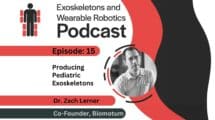Clinical effectiveness and safety of powered exoskeleton-assisted walking in patients with spinal cord injury: systematic review with meta-analysis. This report was published in Medical Devices: Evidence and Research with authors Angela K. Zimmerman, William G. Herbert and Larry E. Miller.
What was done?
The authors conducted a meta-analysis for powered exoskeletons used for spinal cord injury rehabilitation. A meta-study pools together multiple small studies to emulate the results of a single large study. For example, if there is one publication that suggests water is not wet, its conclusion will be drowned out by the multiple studies that show that water is indeed wet. Ideally, a meta-study decreases error and produces a more clear and accurate picture on a subject. Of course meta-studies have their own problems. For example, if a bias or error was present in the majority of the studies used for the meta-analysis, it will be directly transferred to the results of the meta-study. For more, see wikipedia article on meta-analysis.
How was the meta-study conducted?
The authors screened 108 abstracts of published papers. Out of those screened 48 were found to be relevant to powered exoskeletons for rehabilitation due to spinal cord injury. The authors purchased the full text of the 48 papers and further filtered them down based on study size, length and stability assistive devices. Upper body powered exoskeletons and lower body exos that were used only on a treadmill were excluded. Also, only papers published in English were used for this meta-study (which is sure to have suppressed results for the Hal by CYBERDYNE and the Hank by Gogoa). Finally, “hybrid exoskeletons that required volitional contraction of the lower extremities and exoskeletons that required use of a walker” were also excluded. Excluding hybrid exoskeletons most likely refers to studies with wearable robots used in conjunction with FES (Functional Electrical Stimulation) of the spine. Exoskeletons that “require a walker” is very ambiguous as any of the major rehabilitation exoskeletons (Hal, Ekso GT, ReWalk, Indigo, etc) can be used with a walker.
In the end the list of published studies used for the meta-analysis was narrowed down to 14 with a total of 111 patients. Eight studies used the ReWalk exoskeleton, three the Ekso GT, two the Indego and one had an unknown powered exoskeleton.
What did the meta-study conclude?
The main conclusion of the study was that it was safe to use powered exoskeletons for spinal cord rehabilitation. For all 14 studies there were only a total of 3 falls reported and all three were while using obsolete equipment that is no longer used.
This may not look like a giant discovery, but is actually quite important to further the case for adopting rehabilitation exoskeletons. Here is an example problem: Social media is filling with videos of patients trying out an exoskeleton for the first time. However, the majority of users strapped in a rehabilitation exoskeleton do not take even one step in the first session. So the internet is filling up with videos of people wobbling, leaning to all sides, and being caught mid air while falling. This meta-analysis is like inserting a camera that follows multiple patients in multiple hospitals over the entire course of their rehabilitation program, and it shows that it is safe to use the exos.
Additionally, US media has become very prone to publishing unverified research publications, especially if they have wild or contradictory to common sense claims. Just a few weeks ago a study flooded the news channels that hugging dogs caused the pets stress and discomfort. Even though the study was proven to be unverified, and used nothing but 200 Google images of dogs looking directly at the camera it is still being circulated and discussed. Meta-studies can reduce the noise and provide a more consistent picture of the exoskeleton industry to the public.
Working together.
One special note is that the study does not differentiate between the different companies and exoskeletons and neither does the public. All producers of rehabilitation exoskeletons are now bound to affect the reputation of one another. Even though they are made by competing companies, all rehabilitation devices had to prove themselves to be safe to operate for this meta-study to have a positive conclusion. This will also be the case in the future. Breakthroughs and successes of one company will have a beneficial effect on their competitors. Inversely, if one company messes up it will drag down the reputation of all.
Sources:
Full paper can be downloaded at DovePress: Clinical effectiveness and safety of powered exoskeleton-assisted walking in patients with spinal cord injury: systematic review with meta-analysis, Mar 2016, Larry E Miller,1 Angela K Zimmermann,1 William G Herbert,1,2
1Miller Scientific Consulting, Inc., Asheville, NC, 2Department of Human Nutrition, Foods, and Exercise, Virginia Tech, Blacksburg, VA, USA
ReWalk Press Release: First-Ever Meta-Analysis of Exoskeleton Technologies Concludes Powered Exoskeleton Systems Permit Safe Ambulation in Real-Life Settings and Produce Health Benefits, Apr, 2016








Add Comment